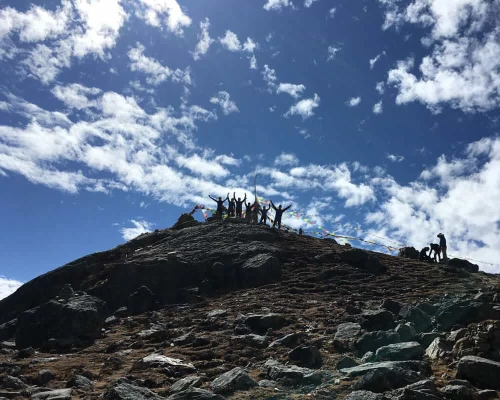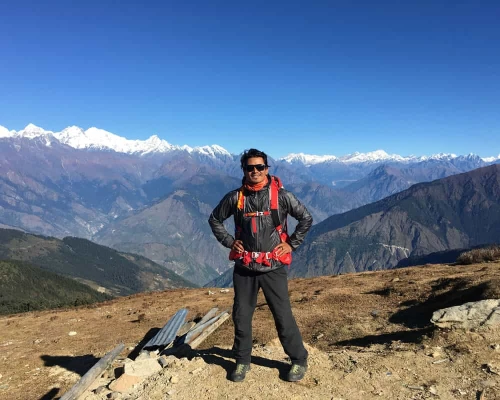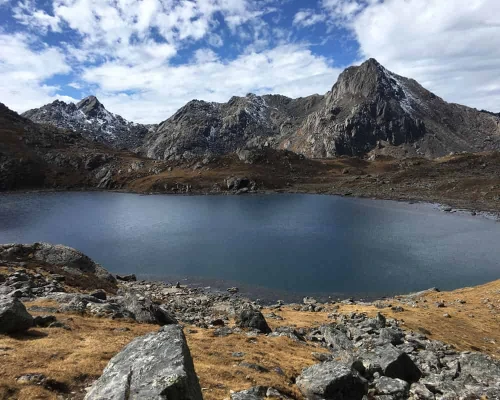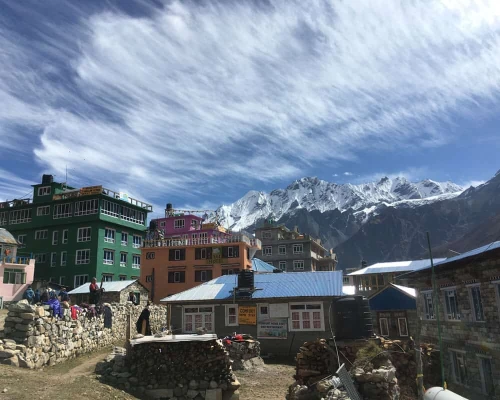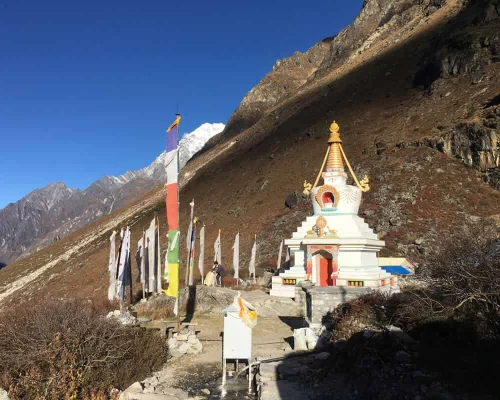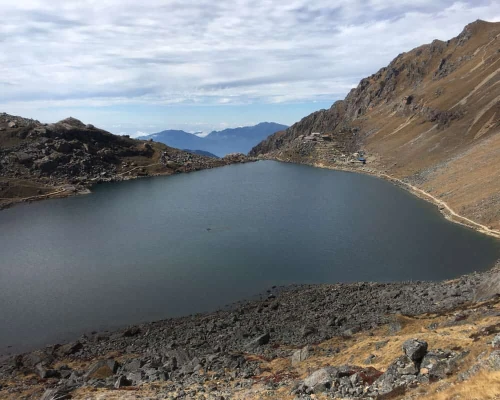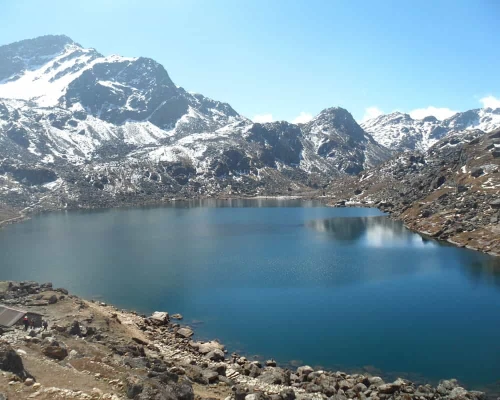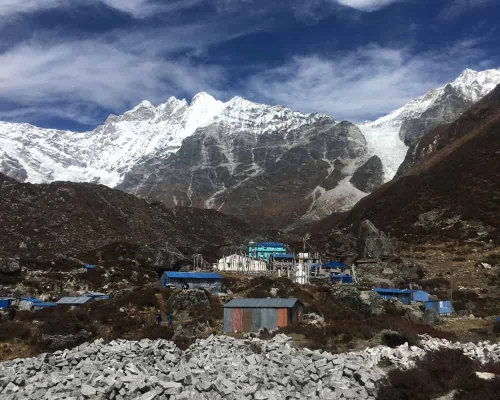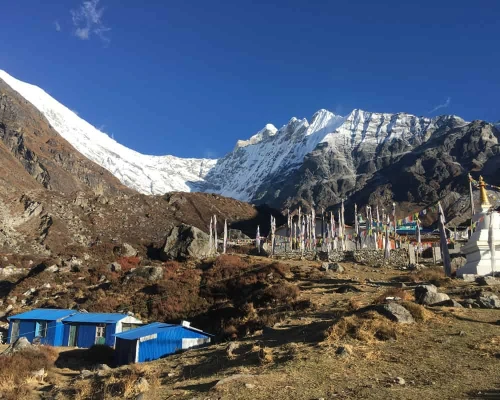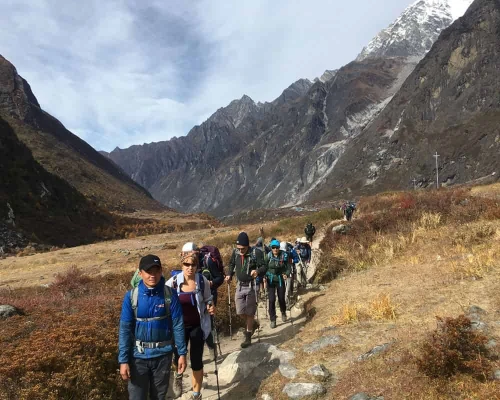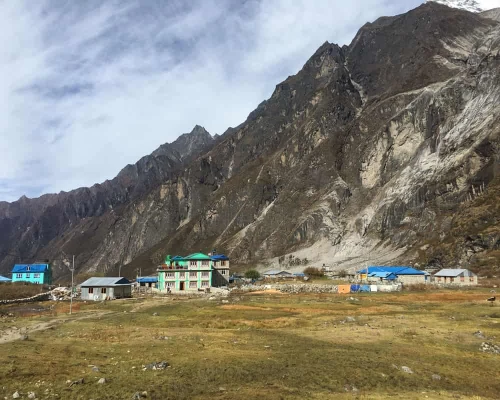Langtang Gosaikunda Trek Anti-Clockwise Overview:
This 15-day Langtang Gosaikunda Trek Anti-Clockwise takes you to the beautiful and remote area of Langtang. The Langtang Valley is one of the closest Himalayan trekking destinations to Kathmandu. This beautiful valley is located approximately 80 km North of the Kathmandu Valley. Langtang National Park was recognized in 1976 and is Nepal's First Himalayan National Park.
The Langtang Gosaikunda Trek Anti-Clockwise trail cruises through traditional Tamang Villages, dramatic forests, a deep valley, and a high mountain pass. It offers stunning mountain views of popular mountain peaks like Langtang Lirung, Ganesh Himal, Gangchenpo, Naya Kangri, Yala Peak, Dorje Lakpa, and many more.
This classical trek also provides the opportunity to explore the diverse culture and lifestyle of the TAMANG people who reside in the valley. The Tamangs in the valley are believed to be Tibetan-origin people who migrated to Nepal centuries ago. They co-existed with the indigenous community of Tamang since then. They have a unique culture and tradition that is similar to Tibet.
This Langtang Gosaikunda Circuit Trek is less trodden and isn't as crowded as the popular Everest Circuit Trek or Annapurna Circuit Trek. However, this Anti Clockwise Trekis an unforgettable experience that offers a unique blend of natural beauty, culture, and adventure
This Langtang Gosaikunda circuit Trek usually takes 15 days, but with us, you can customize your itinerary as per your preference. The starting point of the trek is Sundarijal, which can be reached by a scenic drive from Kathmandu. From there, the trekking trail takes you through 3 different valleys - the Valley of Helembu, the Valley of Gosaikunda, and eventually the Valley of Langtang.
If you are looking for a unique and challenging trekking experience near Kathmandu, then Langtang Gosaikunda Trek Anti-Clockwise will be a perfect choice.
Langtang Gosaikunda Trek Anti-Clockwise Highlights:
- Diverse flora and fauna, including rare species like the Red Panda.
- Explore the beautiful valley, surrounded by majestic mountains, dramatic forests, and picturesque landscapes.
- Visit the ancient Buddhist monastery of Kyanjin Gompa.
- Hike up to Kyangjin Ri for grandiose mountain views.
- Overnight at sacred Gosaikunda Lake and enjoy the serene and mystical atmosphere.
- Enjoy the warm hospitality from the Tamang ethnic community as you pass through their traditional villages.
- Climb Tserko Ri (5033 meters) for a breathtaking sunrise view.
- Visit the Nak (female yak) Cheese factory.
- Try traditional dishes like dal Bhat (lentil soup with rice), Tibetan Bread, momo (dumplings), and yak cheese.
- Enjoy the less crowded trail with the peace and solitude of the Langtang Gosaikunda Trek Anti-Clockwise.
History
The history of Langtang Valley can be traced back to prehistoric times. However, the history of the region is said to have begun with the arrival of Tibetans from Tibet. These people migrated to the area in the 8th century due to the proximity to the Nepal-Tibetan border. In the course of time, these migrated Tibetans started settling in the region, living with the TAMANGS, the then indigenous community.
Over time, the Tibetan people adopted their self-identity as Tamang while co-existing with the indigenous and established several monasteries and settlements. The 'Tamang' which actually means 'Horse Traders' are considered courageous but peace-loving people. They have a very unique culture and speak their own language.
In the 19th century, Langtang Valley became a major trade route between Tibet and Nepal. Traders from Tibet crossed the high mountain passes to exchange goods such as salt, wool, and medicinal herbs. Over time, this trade route was also used by famous mountaineers and explorers. In the late 1800s, it is said that famous personnel like British surveyor William T. H. Green and French geographer Jules-Louis Dozon visited the Langtang Valley.
However, during the 1950s, the Langtang Valley became a refuge for Tibetan refugees fleeing Chinese rule in their homeland. During that period, the Nepalese government allowed the refugees to settle in the region.
Today, Langtang Valley is a popular trekking destination, with thousands of tourists visiting the area each year. Travelers from around the world come to enjoy its stunning natural beauty and rich cultural heritage.
Tragically, in April 2015, the region was severely devastated by the 8.1 magnitude earthquake. This Tragic earthquake caused widespread damage and loss of life in the Langtang Valley, killing many. Even now, though it has been 10 years, efforts are still underway to rebuild and restore the region.
Lauribina Pass 4,610m / 15,124 feet:
The Lauribina Pass is at a height of 4,610m, which is 15,124 feet. This high mountain pass is a bridge between the holy Gosaikunda Lake and the Helembu Valley. Trekkers can go clockwise or anti-clockwise over the Lauribina Pass to explore these untouched valleys. The journey over this mountain pass is certainly a beautiful experience that offers an unforgettable memory of beauty.
Trekking via Lauribina Pass to holy Gosaikunda Lake is an extraordinary adventure that very few have the privilege to walk this stunning path. It transports you to a world of natural beauty and spiritual significance. As the trail gradually gains elevation, the landscape transforms, taking you to the pristine alpine meadows with wildflowers.
As you approach the summit of Lauribina Pass, the trek becomes more challenging with vertical ascent. However, as you get to the summit, the reward you receive is worth your efforts. The summit, in reality, is a great vantage point offering you a stunning view of the majestic surroundings.
From this vantage point, the panoramas are simply breathtaking. It offers you a 360-degree view of the surrounding peaks, landscapes, and valleys. The highlight will be the view of the extended Holy Gosaikunda Lake, which shines like a gem in the distance.
As you slowly descend the alpine gully, you will be greeted by the sacred and tranquil water of glacial Gosaikunda Lake. Since we will be having lunch here, you will have enough time to explore and enjoy the lake and the view.
However, walking over the high mountain Lauribina Pass is certainly an unforgettable experience. It combines natural beauty, physical challenge, and spiritual significance that can be cherished forever.
Holy Gosaikunda Lake 4,380 m/ 14,370 feet
Holy Gosainkunda Lake is a gorgeous Himalayan freshwater lake located in the district of Rasuwa in the region of Langtang. This high-altitude lake is a sacred pilgrimage site for both Hindus and Buddhists.
The name GOSAIKUNDA can be broken down into two terms ‘GOASAI’ or ‘GOSAIN’ which means master or the lord and ‘KUNDA’ means pool or the lake. So literally it means LORD LAKE. Here, the lord is referred to as Lord Shiva, the supreme deity in Hinduism.
According to ancient Hindu Mythology, it is believed that GOSAIKUNDA was created by Lord Shiva. It is said that Lord Shiva had to pierce a glacier with his powerful trident, a TRISHUL, to get icy water to cool his poisoned throat.
The GOSAIKUNDA LAKE is situated at a height of 4,380 meters (14,370 feet). It is surrounded by snow-capped mountains, including the Langtang Lirung and Ganesh Himal ranges. The lake is fed by several streams and has a surface area of about 13.8 hectares (34 acres). The water in the lake is crystal clear and its turquoise waters reflect the sky above which is stunning.
The serenity of Gosaikunda Lake and the spiritual significance of the region make it a popular destination for tourists both national and international. The trek to the holy Gosainkunda Lake is considered to be one of the most popular and stunning treks in Nepal that offers a memorable experience.
Langtang Village and 2015 Earthquake:
Langtang Village is a place of natural beauty seated in the deep valley at the base of Langtang Lirung and other significant high cliffs. Before the 2015 earthquake, Lantang was a thriving village, known for its medieval-style architecture, ancient monasteries, cheese factory, and traditional Tamang culture.
However, the tragic 8.1 magnitude earthquake of 2015 that happened in April caused significant damage, sweeping away the entire village. The avalanche from the Langtang Lurung triggered a massive landslide that swept down the main village, killing many locals and foreign trekkers.
After this devastating Earthquake, Langtang Village was slowly rebuilding and recovering, but again COVID-19 put a halt for the next 3 years. However, Langtang is gradually rehabilitating and the resilience and determination of the local community are evident as seen in the now progress. Today, you can witness the remarkable transformation that has taken place in the village.
The village offers a glimpse into the daily lives of the Tamang people, who are known for their rich cultural heritage. You can still see traditionally built stone houses with prayer flags and prayer walls that create a picturesque, rustic setting.
This lovely village is surrounded by majestic mountains, including Langtang Lirung, Langtang II, and Naya Kang. It is a place where nature and culture intertwine, offering a unique and unforgettable experience.



